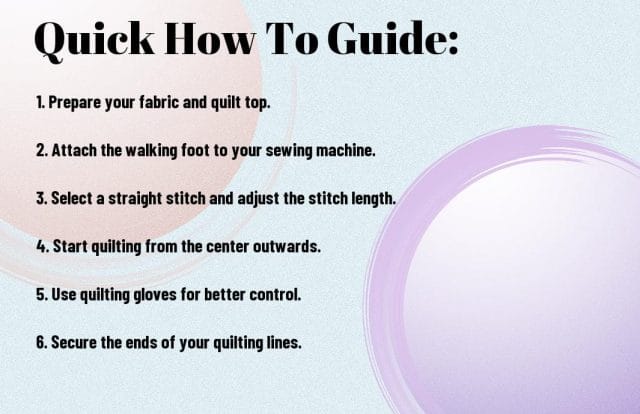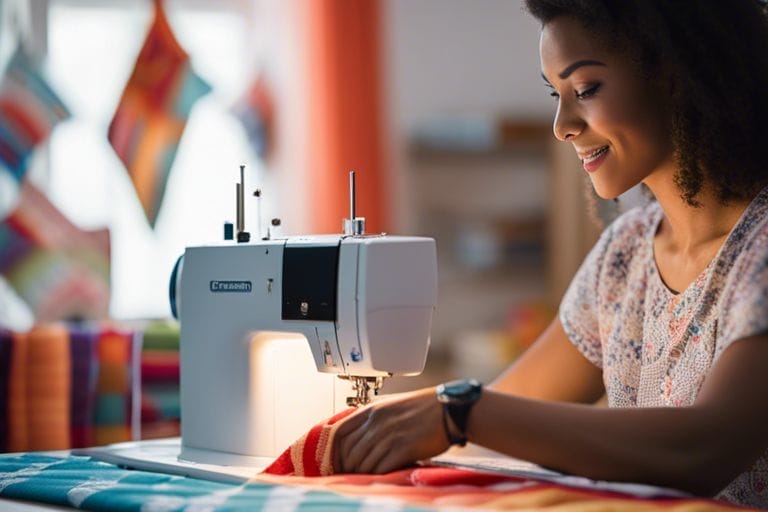Embarking on your quilting journey can be both exciting and daunting, especially when it comes to mastering the art of using a walking foot. However, with the right guidance and a few essential tips, you can confidently and efficiently quilt with a walking foot like a pro. In this beginner’s guide, we will walk you through the essential steps, techniques, and best practices for using a walking foot to create beautiful and professional-looking quilts. Whether you’re a complete novice or have some experience, this guide will empower you to take your quilting skills to the next level. So, let’s dive in and master the art of quilting with a walking foot!
Key Takeaways:
- Understanding the Walking Foot:
- It is a specialized sewing machine foot designed for quilting.
- It helps to feed multiple layers of fabric evenly through the machine.
- Choosing the Right Supplies:
- Ensure you have the correct walking foot for your specific sewing machine model.
- Invest in high-quality quilting thread and fabric to achieve professional-looking results.
- Mastering The Technique:
- Practice stitching in straight lines and gentle curves to build confidence and improve control.
- Experiment with different quilt patterns and designs to enhance your skills and creativity.
- Troubleshooting Common Issues:
- Learn how to avoid puckering and how to fix it if it occurs during quilting.
- Understand how to handle bulky seams and thick quilt layers to prevent sewing machine jams.
- Exploring Advanced Techniques:
- Discover how to create intricate quilting designs and motifs using a walking foot.
- Learn how to incorporate decorative stitches and patterns to add dimension and texture to your quilts.

Preparing to Quilt with a Walking Foot
Obviously, before you start quilting with a walking foot, there are some important preparation steps to take. One useful resource to consult is the Walking foot guide bar – To the left? thread on the Missouri Star Quilt Co. forum, which can provide some helpful tips and insights. Here are some key steps to take before you begin quilting with a walking foot:
Selecting Your Quilting Fabric
When selecting fabric for quilting with a walking foot, it’s important to consider the weight and weave of the fabric. You want to choose fabrics that are compatible with the walking foot and will feed smoothly through your sewing machine. Avoid using fabrics that are too heavy or too loosely woven, as they may cause uneven stitching and tension issues.
Setting Up Your Sewing Machine
Before you start quilting with a walking foot, you need to make sure your sewing machine is properly set up. This includes installing the walking foot attachment and adjusting the stitch length and tension to accommodate the thickness of the quilt sandwich. Properly setting up your sewing machine will help ensure smooth and even stitching as you quilt.
The Importance of Proper Thread Tension
Thread tension is a critical factor in quilting with a walking foot. If the tension is too loose, you may end up with loose, loopy stitches, while too-tight tension can cause puckering and distortion of the fabric. It’s crucial to adjust the thread tension to achieve balanced, even stitches as you quilt with a walking foot.
Quilting Techniques with a Walking Foot
Lastly, let’s explore some quilting techniques you can use with a walking foot to create beautiful and professional-looking quilts. Whether you are a beginner or have some experience with quilting, these techniques will help you elevate your quilting game and achieve stunning results.
Straight Line Quilting Tips
When quilting with a walking foot, straight line quilting is one of the most common techniques. To ensure straight and even stitches, make sure to mark your quilting lines using a quilting ruler and fabric marking pen. Adjust your walking foot’s guide bar to the width you want between your quilting lines. While quilting, use your hands to gently guide the quilt through the machine, keeping the fabric taut but not stretched. This will help you achieve even stitches and prevent tucks or puckers in your quilt. Additionally, consider using a walking foot with a built-in guide to help you maintain consistent spacing between your quilting lines. Though straight line quilting may seem basic, mastering this technique is essential for any quilter as it forms the foundation for many other quilting styles.
Creating Decorative Patterns
If you want to add decorative patterns to your quilts using a walking foot, consider using the built-in guide on your walking foot to create evenly spaced parallel lines and geometric shapes. Experiment with different stitch lengths and designs to add texture and visual interest to your quilt. You can also use decorative stitches with your walking foot to create unique patterns. Remember to practice on scrap fabric first to ensure you are comfortable with the design and stitch settings. Adding decorative patterns with a walking foot can take your quilts to the next level and add a personalized touch to your creations.
Managing Quilt Layers and Reducing Bulk
When quilting with a walking foot, managing quilt layers and reducing bulk is essential to ensure smooth and even quilting. Start by basting your quilt layers together with quilting pins or spray baste to prevent shifting and puckering. If your quilt becomes too bulky to fit through your sewing machine, consider rolling the excess quilt fabric to fit it under the arm of your machine. Sew slowly and adjust the fabric as needed to prevent tucks and folds. Additionally, consider using a walking foot with a longer guide if you are working with thick quilt layers. Thoroughly understanding how to manage quilt layers and reduce bulk will help you achieve professional-looking quilting results.
Advanced Tips for Walking Foot Quilting
Your successful use of a walking foot for quilting can be further enhanced with some advanced tips and techniques. Here are some additional pointers to help you take your quilting to the next level:
- Stitch Length and Tension: Adjust your stitch length and tension according to the type of fabric and batting you are using. Test different settings on scrap fabric to achieve the best results.
- Even Feed: Make sure your walking foot is properly engaged with the fabric to ensure an even feed. Keep your hands lightly on the fabric to guide it through, but let the walking foot do the work.
- Directional Quilting: Pay attention to the direction of your quilting lines, especially when working with directional fabrics. Plan your quilting design to complement the fabric’s pattern.
- Needle Position: Experiment with different needle positions to achieve precise quilting lines and to work around seams and bulky areas.
Navigating Curves and Corners
When quilting with a walking foot, navigating curves and corners can be challenging. Start by marking the quilting lines with a hera marker or fabric chalk to guide you as you sew. When approaching a curve, take your time and use the hand wheel to sew one stitch at a time, pivoting the fabric as needed. For sharper corners, you may need to stop with the needle down, lift the presser foot, and pivot the fabric before continuing. Remember to practice on scrap fabric to gain confidence in handling curves and corners.
Factor Considerations for Speed and Pressure
Adjusting the speed and pressure of your sewing machine is crucial for successful walking foot quilting. You want to maintain a consistent speed to ensure even stitches, especially when quilting intricate designs. Additionally, experiment with different pressure settings on your walking foot to find the right balance for smoothly feeding the layers of fabric and batting through the machine. Remember that too much speed or pressure can result in uneven stitches and fabric shifting, so take your time to find the optimal settings for your project.

Troubleshooting Common Issues
After familiarizing yourself with the basics of quilting with a walking foot, you may encounter some common issues that can arise during the quilting process. It’s important to address these issues promptly to ensure the quality of your finished quilt. For more tips on machine quilting with a walking foot, you can refer to Tips for Machine Quilting With a Walking Foot.
Addressing Skipped Stitches
If you notice that your walking foot is skipping stitches, it can be frustrating and may affect the overall appearance of your quilt. One common reason for skipped stitches is using the wrong type or size of needle for the fabric and thread you are using. Make sure you are using a needle appropriate for the weight and type of fabric, as well as the thread you have chosen. Additionally, check that the needle is inserted correctly and is not bent or damaged. Sometimes, simply replacing the needle can resolve the issue. Remember, a dull or damaged needle can cause skipped stitches, so be sure to change your needle regularly to maintain the quality of your quilting.
Resolving Fabric Puckering
Fabric puckering, or the appearance of small wrinkles in the fabric, can detract from the professional look of your quilt. This issue can often be attributed to incorrect tension settings on your machine. Check the tension of both the upper thread and the bobbin thread, and make adjustments as needed to achieve balanced tension. Another factor that can cause fabric puckering is sewing too quickly. Take your time and sew at a steady pace to avoid fabric puckering and ensure smooth, even stitches.

Conclusion
On the whole, learning how to quilt with a walking foot is an essential skill for any beginner quilter. By mastering the techniques and tips outlined in this guide, you can confidently create beautiful and professional-looking quilt projects. Remember to practice patience and precision as you work with your walking foot, and don’t be afraid to experiment and try new patterns. With dedication and practice, you’ll soon be quilting like a pro. For more in-depth tips and tutorials, you can always visit Quilting with the Walking Foot on We All Sew. Happy quilting!
FAQ
Q: What is a walking foot in quilting?
A: A walking foot, also known as an even feed foot, is a sewing machine attachment that helps to feed multiple layers of fabric evenly through the machine. It has built-in feed dogs that work in conjunction with the machine’s feed dogs to prevent layers of fabric from shifting and stretching as they are sewn together. This is particularly useful when quilting, as it helps to maintain consistent stitch length and prevents puckering or stretching of the quilt layers.
Q: Why is it important to use a walking foot for quilting?
A: Using a walking foot for quilting is important because it helps to prevent the layers of fabric from shifting or stretching as they are sewn together. This is especially crucial when working with multiple layers of fabric, batting, and backing in a quilt. The walking foot ensures that all layers are fed through the machine evenly, resulting in a more professional-looking and well-constructed quilt. It also helps to maintain a consistent stitch length and reduces the likelihood of fabric bunching or puckering.
Q: How do I quilt with a walking foot as a beginner?
A: To quilt with a walking foot as a beginner, start by selecting a quilting design and marking it on your quilt top. Attach the walking foot to your sewing machine and install a quilting needle. Sandwich your quilt layers together (quilt top, batting, and backing) and baste them securely. Begin quilting by starting in the center of the quilt and working your way outwards, using the walking foot to guide the fabric through the machine. Go slowly and practice keeping your stitches even. As you gain confidence, you can experiment with different quilting designs and techniques, always using the walking foot to ensure even stitching.

